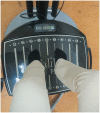Short-term effects of side-alternating Whole-Body Vibration on cognitive function of young adults
- PMID: 36634088
- PMCID: PMC9836316
- DOI: 10.1371/journal.pone.0280063
Short-term effects of side-alternating Whole-Body Vibration on cognitive function of young adults
Abstract
Recent research in rodents and humans revealed that Whole-Body Vibration (WBV) is beneficial for cognitive functions. However, the optimal WBV conditions are not established: contrary to vertical WBV, side-alternating WBV was not investigated before. The present study investigated the short-term effects of side-alternating WBV in standing and sitting posture on specific cognitive function of young adults. We used a balanced cross-over design. Sixty healthy young adults (mean age 21.7 ± 2.0 years, 72% female) participated. They were exposed to three bouts of two-minute side-alternating WBV (frequency 27 Hz) and three control conditions in two different sessions. In one session a sitting posture was used and in the other session a standing (semi-squat) posture. After each condition selective attention and inhibition was measured with the incongruent condition of the Stroop Color-Word Interference Test. WBV significantly (p = 0.026) improved selective attention and inhibition in the sitting posture, but not in the standing posture. The sitting posture was perceived as more comfortable, joyous and less exhaustive as compared to the standing posture. This study demonstrated that side-alternating WBV in sitting posture improves selective attention and inhibition in healthy young adults. This indicates that posture moderates the cognitive effect of WBV, although the effects are still small. Future studies should focus on the working mechanisms and further optimization of settings, especially in individuals who are unable to perform active exercise.
Copyright: © 2023 Arenales Arauz et al. This is an open access article distributed under the terms of the Creative Commons Attribution License, which permits unrestricted use, distribution, and reproduction in any medium, provided the original author and source are credited.
Conflict of interest statement
The authors have declared that no competing interests exist.
Figures






Similar articles
-
The acute effects of whole-body vibration exercise on cortical activation in young adults: An fNIRS study.Behav Brain Res. 2025 Mar 5;480:115381. doi: 10.1016/j.bbr.2024.115381. Epub 2024 Dec 5. Behav Brain Res. 2025. PMID: 39644997 Clinical Trial.
-
Whole body vibration improves cognition in healthy young adults.PLoS One. 2014 Jun 20;9(6):e100506. doi: 10.1371/journal.pone.0100506. eCollection 2014. PLoS One. 2014. PMID: 24949870 Free PMC article. Clinical Trial.
-
Acute Effects of Whole Body Vibration on Inhibition in Healthy Children.PLoS One. 2015 Nov 2;10(11):e0140665. doi: 10.1371/journal.pone.0140665. eCollection 2015. PLoS One. 2015. PMID: 26524188 Free PMC article.
-
Good vibrations--effects of whole body vibration on attention in healthy individuals and individuals with ADHD.PLoS One. 2014 Feb 28;9(2):e90747. doi: 10.1371/journal.pone.0090747. eCollection 2014. PLoS One. 2014. PMID: 24587412 Free PMC article. Clinical Trial.
-
The effects and possible mechanisms of whole-body vibration on cognitive function: A narrative review.Brain Res. 2025 Mar 1;1850:149392. doi: 10.1016/j.brainres.2024.149392. Epub 2024 Dec 9. Brain Res. 2025. PMID: 39662790 Review.
Cited by
-
Therapeutic Approach of Whole-Body Vibration Exercise on Wound Healing in Animal Models: A Systematic Review.Int J Environ Res Public Health. 2023 Mar 10;20(6):4925. doi: 10.3390/ijerph20064925. Int J Environ Res Public Health. 2023. PMID: 36981833 Free PMC article.
-
The effects of whole-body vibration therapy on immune and brain functioning: current insights in the underlying cellular and molecular mechanisms.Front Neurol. 2024 Jul 31;15:1422152. doi: 10.3389/fneur.2024.1422152. eCollection 2024. Front Neurol. 2024. PMID: 39144715 Free PMC article. Review.
References
-
- Sá-Caputo DC, Coelho-Oliveira AC, Pessanha-Freitas J, Paineiras-Domingos LL, Lacerda ACR, Mendonça VA, et al.. Whole-body vibration exercise: A possible intervention in the management of post COVID-19 complications? Applied Sciences. 2021;11(12):5733.
MeSH terms
LinkOut - more resources
Full Text Sources

